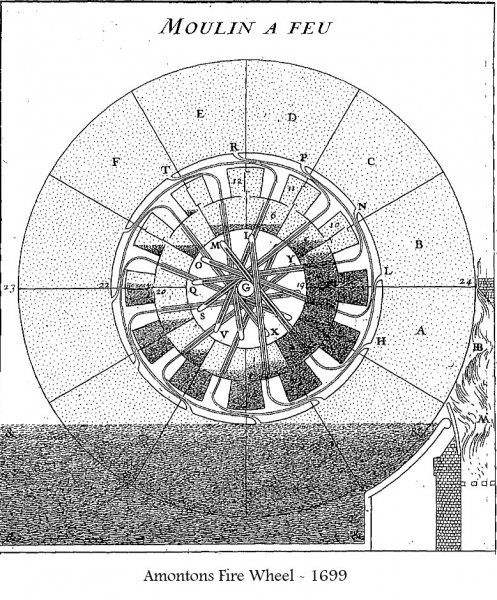Amontons' description
Taking into account what has been stated previously see here A, B, C, D, E, F and 1, 2, 3, 4, 5, 6 are two circular and concentric rows of cells arranged around a horizontal and movable axis G, and closed on all sides.
The cells A, B, C, D, E, F, communicate to each of the cells 1, 2, 3, 4, 5, 6, by means of the tubes HI, LM , NO, PQ, RS, TV.
The cells 1, 2, 3, 4, 5, 6, communicate with each other by means of valves 7, 8, 9, 10, 11, 12, which all open in the same direction, so that it allows the water to pass from the first to the second cell, then from the second to the third, from the third to the fourth, from the fourth to the fifth, and so on until the last, and again the latter to the first, but refuse the water to flow in the opposite direction.
The cells A, B, C, D, E, F have no direct communication between them, and the cells 1, 2, 3, 4 have two openings like X, Y, through which they are filled with water. When the capacity of each of the cells 1, 2, 3, 4, 5, 6 is about the seventh part of that of the cells A, B, C, D, E, F, the apertures are closed as the resistant force is supposed to balance with the water of the cells 1, 2.

Finally by applying in BB the flame coming out of the furnace AA, that is pushed by the air which enters by the grid of the furnace, and having the bottom of the wheel dipping in the water tank, I say:
-
The air of the cell B will increase its spring sufficiently to support not only the height of water IY, but also to pass the water from the cell 1 to the cell 3, if this height IY is only about five feet.
-
The weight of this water will turn all this construction in the direction B, A, F around the center G, if the resistant force is less than this weight.
- As the wheel rotates around the center G, the water in Y tends to descend and the next cells reach in BB. Again the air increases its spring, pushes the water up at a height sufficient for its weight to be continuously higher than the resistant force. By doing this, the cells containing the air that has been dilated, pass through the cold water reservoir. The dilated air shrinks, and do so further when the cells pass through the open air, to finally decrease to its original volume.It will then anew receive spring when passing by BB.